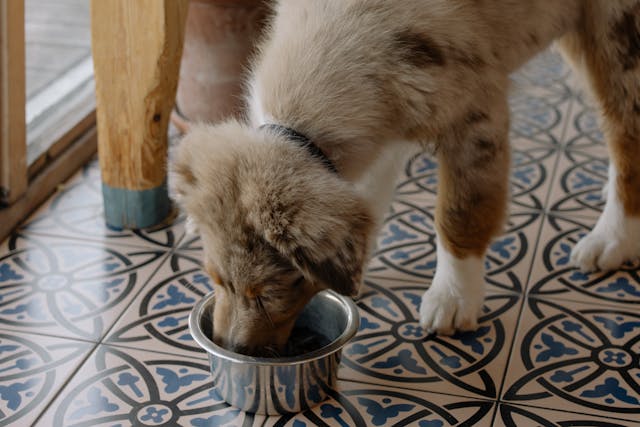It’s no secret that the way to a dog’s heart is through their stomach. But is wet or dry food better for dogs? Whether your dog prefers both wet or dry dog food, preparing a special meal for your pet using both will engage all five of their senses.

Your dog craves variety. It’s shown that by adding variety to your pets’ meals you can improve their happiness, health and mental and physical wellbeing.
Introducing mixed feeding as part of their routine is a great way to excite their senses while also packing their bowl full of nutrients that will benefit their coat, wellbeing, digestion and mood.
What is mixed feeding?
Mixed feeding is when you feed your dog a meal made up of both dry and wet, fresh, frozen, or raw dog food. Ideally, every component of your mix is a complete and balanced diet.
What’s the recommended ratio of dry to wet, fresh, frozen, or raw dog food?
For most dogs, 70% dry dog food mixed in with 30% either fresh, frozen, wet or raw dog food is the recommended ratio.

How does feeding wet and dry dog food engage your dog’s senses?
Smell
A dog’s sense of smell is estimated to be 100,000 times more powerful than a human. They can differentiate each individual ingredient based on the scent profiles alone. So, it’s no surprise that when it comes to deciding what to eat, a dog is led by their nose.
When building your dog’s bowl, smell is the best sense to entice and excite your pet when it comes to mealtimes. Incorporating a variety of scent profile keeps things interesting. When building your dog’s bowl, utilise animal proteins, vegetables, fruits and other flavourful, nutrient dense foods or combinations.
You can further stimulate your dog’s sense of smell – and keep them occupied — by feeding them in a novel way. Instead of feeding them in a bowl, put their meal in a puzzle feeder that they need to solve before they can eat. Or hide bits and pieces house or yard so they have to search for it.
Taste
Dogs only have around 1700 taste buds. For context: humans have about 9000. Therefore, taste isn’t as important as smell when it comes to convincing your dogs to try a food.
However, your dog may still develop a preference for some animal proteins, vegetables, and fruits over others. Incorporate your dog’s favourite flavours into their bowls. Or take the opportunity to have them try something new.
Sight
Dogs aren’t known for their great vision. They tend to be near-sighted and their perception of colours somewhat resembles a human who is colour blind.
Your dog doesn’t care if their dinner has Instagram-worthy presentation. Rather than designing them an aesthetically pleasing bowl, make them the happiest dog on the planet by ensuring that there are a mixture of smells, tastes, and textures for an exciting mealtime.
Sound
Your dog knows what dinnertime sounds like. Get your pet excited by using various sounds to signify mealtime. Dry food pouring against a bowl or a spoon rattling around a can is a great way to call them to dinner and create an exciting ritual.
Touch
The sense of touch is all about feeling and there are two ways to accomplish this with food: temperature and texture.
Experiment with temperature to bring out different aromas in your dog’s bowl. Gently-warmed food has a stronger aroma, which can make dinner more appealing to dogs. Mix in some slightly warm bone broth. Take care not to make the food too hot – it can not only burn your dog’s mouth but may also change the nutritional value of the food.
Don’t neglect texture when building your dog’s bowl. Dry food is fairly uniform as the base, but there is so much you can do with the toppers and wet, fresh, or frozen components.
Contrast the crunchy kibble with chewy, dense air-dried diets or delicious, casserole wet dog food, cooked pumpkin, or anything that adds a mixture of textures for your dog. Adding in a dental stick, or dental chews and other treats within a variety bowl can add to the taste of your dog’s bowl.
Filling your bowl out with combination foods to add balance as well is a great tool to add to your dog’s palate with meats, vegetables or dry food combos.

Don’t spend too much time worrying if dry food or wet food is better for your dog. Give your dog variety by feeding both and mixed feeding. By adding more variety to your dog’s bowl and engaging all their senses, you’re making feeding time more enjoyable and satisfying.
Not every food can be part of the mix
Remember: what’s good for you isn’t always good for your pet. So, before you start thinking of feeding them last’s nights leftovers or all organic produce, it’s important to understand how to mix up the menu and build a bowl that’s safe, nutritonally balanced, and exciting for your dog. It’s always safest to stick to foods made specifically for dogs.
Some of the toxic food for dogs to avoid include:
- cooked bones — they can splinter and cause gastrointestinal damage
- onions and onion powder
- garlic
- chocolate
- coffee or caffeine products
- mouldy or spoiled foods or compost
- bread dough and yeast
- grapes, raisins, sultanas (including in desserts) and currants
- nuts (macadamia nuts in particular)
- fruit stones
- Corn cobs
- fatty trimmings/ fatty foods
- xylitol (an artificial sweeterner in many sugar-free chewing gum, lollies, baking goods, toothpaste and peanut butter)
If your dog shows signs they’ve eaten something toxic, contact your nearest veterinary clinic or emergency veterinary hospital as soon as possible.

